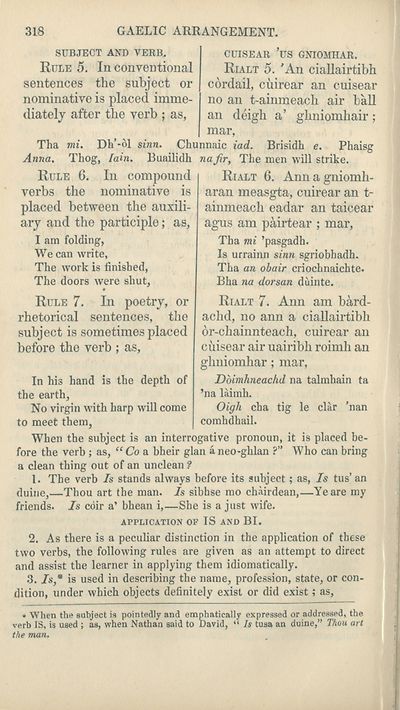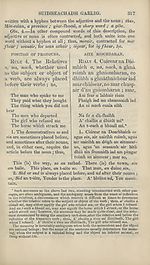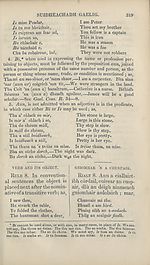Books and other items printed in Gaelic from 1841 to 1870 > Double grammar, of English and Gaelic, in which the principles of both languages are clearly explained
(318) Page 318
Download files
Complete book:
Individual page:
Thumbnail gallery: Grid view | List view

318
GAELIC ARRANGEMENT.
SUBJECT AND VERB.
Rule 5. In conventional
sentences the subject or
nominative is placed imme¬
diately after the verb ; as,
Tha mi. Dh’-61 shin.
Anna. Thog, lain.
Rule 6. In compound
verbs the nominative is
placed between the auxili¬
ary and the participle; as,
I am folding,
We can write,
The work is finished,
The doors were shut,
Rule 7. In poetry, or
rhetorical sentences, the
subject is sometimes placed
before the verb ; as,
In his hand is the depth of
the earth.
No virgin with harp will come
to meet them,
CUISEAR US GNIOHHAR.
Rialt 5. ’An ciallairtibh
cordail, ciiirear an cuisear
no an t-ainmeach air ball
an deigh a’ ghniomhair;
mar,
Brisidh e. Phaisg
The men will strike.
Rialt 6. Annagniomh-
aran measgta, cuirear an t-
ainmeach eadar an taicear
agus am pairtear ; mar,
Tha mi ’pasgadh.
Is urrainn sinn sgriobhadh.
Tha an obair criochnaichte.
Bha na dorsan diiinte.
Rialt 7. Ann am bard-
achd, no ann a ciallairtibh
6r-chainnteach, cuirear an
cuisear air uairibh roimh an
ghuiomhar; mar,
Dbimhneachd na talmhain ta
’na laimh.
Oigh cha tig le clar ’nan
comhdhail.
When the subject is an interrogative pronoun, it is placed be¬
fore the verb ; as, “ Co a bheir glan a neo-ghlan ?” Who can bring
a clean thing out of an unclean ?
1. The verb Is stands always before its subject; as, Is tus’ an
duine,—Thou art the man. Is sibhse mo chairdean,—Ye are my
friends. Is coir a’ bhean i,—She is a just wife.
APPLICATION OF IS AND BI.
Chunnaic iad.
Buailidh nafir,
2. As there is a peculiar distinction in the application of these
two verbs, the following rules are given as an attempt to direct
and assist the learner in applying them idiomatically.
3. Is* is used in describing the name, profession, state, or con¬
dition, under which objects definitely exist or did exist; as,
• When the subject is pointedly and emphatically expressed or addressed, the
verb IS, is used ; as, when Nathan said to David, “ Is tusa an duine,” Thou art
the man,
GAELIC ARRANGEMENT.
SUBJECT AND VERB.
Rule 5. In conventional
sentences the subject or
nominative is placed imme¬
diately after the verb ; as,
Tha mi. Dh’-61 shin.
Anna. Thog, lain.
Rule 6. In compound
verbs the nominative is
placed between the auxili¬
ary and the participle; as,
I am folding,
We can write,
The work is finished,
The doors were shut,
Rule 7. In poetry, or
rhetorical sentences, the
subject is sometimes placed
before the verb ; as,
In his hand is the depth of
the earth.
No virgin with harp will come
to meet them,
CUISEAR US GNIOHHAR.
Rialt 5. ’An ciallairtibh
cordail, ciiirear an cuisear
no an t-ainmeach air ball
an deigh a’ ghniomhair;
mar,
Brisidh e. Phaisg
The men will strike.
Rialt 6. Annagniomh-
aran measgta, cuirear an t-
ainmeach eadar an taicear
agus am pairtear ; mar,
Tha mi ’pasgadh.
Is urrainn sinn sgriobhadh.
Tha an obair criochnaichte.
Bha na dorsan diiinte.
Rialt 7. Ann am bard-
achd, no ann a ciallairtibh
6r-chainnteach, cuirear an
cuisear air uairibh roimh an
ghuiomhar; mar,
Dbimhneachd na talmhain ta
’na laimh.
Oigh cha tig le clar ’nan
comhdhail.
When the subject is an interrogative pronoun, it is placed be¬
fore the verb ; as, “ Co a bheir glan a neo-ghlan ?” Who can bring
a clean thing out of an unclean ?
1. The verb Is stands always before its subject; as, Is tus’ an
duine,—Thou art the man. Is sibhse mo chairdean,—Ye are my
friends. Is coir a’ bhean i,—She is a just wife.
APPLICATION OF IS AND BI.
Chunnaic iad.
Buailidh nafir,
2. As there is a peculiar distinction in the application of these
two verbs, the following rules are given as an attempt to direct
and assist the learner in applying them idiomatically.
3. Is* is used in describing the name, profession, state, or con¬
dition, under which objects definitely exist or did exist; as,
• When the subject is pointedly and emphatically expressed or addressed, the
verb IS, is used ; as, when Nathan said to David, “ Is tusa an duine,” Thou art
the man,
Set display mode to:
![]() Universal Viewer |
Universal Viewer | ![]() Mirador |
Large image | Transcription
Mirador |
Large image | Transcription
Images and transcriptions on this page, including medium image downloads, may be used under the Creative Commons Attribution 4.0 International Licence unless otherwise stated. ![]()
| Permanent URL | https://digital.nls.uk/106543581 |
|---|
| Description | Out-of-copyright books printed in Gaelic between 1631 and 1900. Also some pamphlets and chapbooks. Includes poetry and songs, religious books such as catechisms and hymns, and different editions of the Bible and the Psalms. Also includes the second book ever published in Gaelic in 1631. |
|---|

